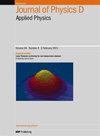基于创新金属石墨烯元表面的可重构太赫兹漏波天线
IF 3.2
3区 物理与天体物理
Q2 PHYSICS, APPLIED
引用次数: 0
摘要
石墨烯欧姆损耗明显阻碍了基于石墨烯的太赫兹(THz)器件的效率。最近有人提出了金属-石墨烯混合结构,以缓解一些无源器件(即波导和维瓦尔第天线以及频率选择性表面)中的这一问题。在这项研究中,对这种技术进行了广泛研究,以优化太赫兹法布里-珀罗腔漏波天线的辐射性能,该天线基于金属-石墨烯混合元表面,由方形金属贴片晶格和互补石墨烯条形光栅交错组成。理论、数值和全波结果表明,通过正确选择单元格特征,可以在可重构范围、天线指向性和损耗之间实现令人满意的权衡。所提出的天线可应用于未来的无线太赫兹通信。本文章由计算机程序翻译,如有差异,请以英文原文为准。
Reconfigurable THz leaky-wave antennas based on innovative metal–graphene metasurfaces
Graphene ohmic losses notably hinder the efficiency of graphene-based terahertz (THz) devices. Hybrid metal–graphene structures have recently been proposed to mitigate this issue in a few passive devices, namely waveguide and Vivaldi antennas, as well as frequency selective surfaces. In this work, such a technique is extensively investigated to optimize the radiation performance of a THz Fabry–Perot cavity leaky-wave antenna based on a hybrid metal–graphene metasurface consisting of a lattice of square metallic patches interleaved with a complementary graphene strip grating. Theoretical, numerical, and full-wave results demonstrate that, by properly selecting the unit-cell features, a satisfactory trade-off among range of reconfigurability, antenna directivity, and losses can be achieved. The proposed antenna can find application in future wireless THz communications.
求助全文
通过发布文献求助,成功后即可免费获取论文全文。
去求助
来源期刊
CiteScore
6.80
自引率
8.80%
发文量
835
审稿时长
2.1 months
期刊介绍:
This journal is concerned with all aspects of applied physics research, from biophysics, magnetism, plasmas and semiconductors to the structure and properties of matter.

 求助内容:
求助内容: 应助结果提醒方式:
应助结果提醒方式:


